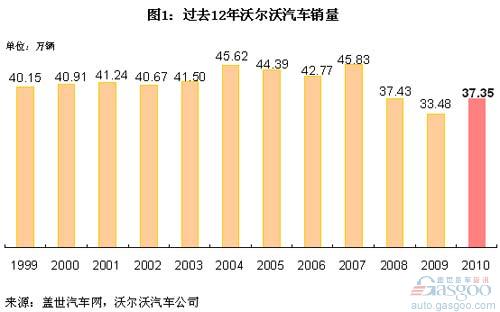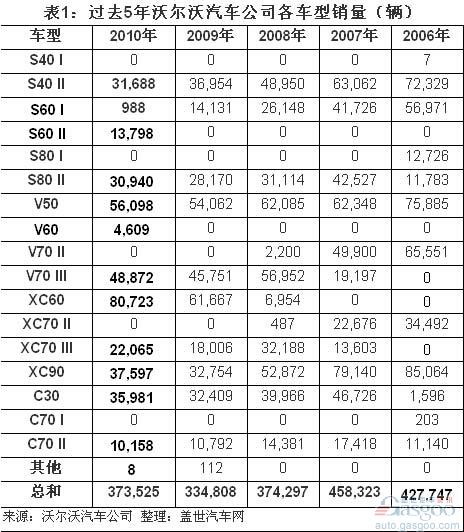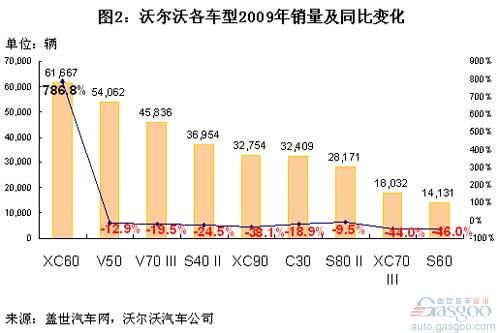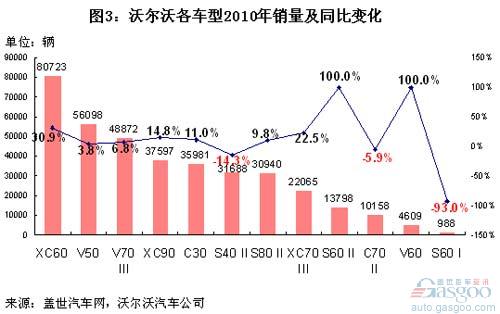In August 2010, Jilin Holding Group completed the acquisition of Volvo Car Corporation. One year later, what is the operating situation of Volvo? We give a brief analysis of its financial status, car sales, and future development strategies.
Financial position: Turning losses into profits 2009 Volvo Car Corporation’s pretax loss was $653 million, which was an improvement over the 2008 loss of $1.465 billion. From the beginning of the first quarter of 2010, Volvo has basically resumed its profit, and maintained the momentum of recovery throughout the year. In 2010, Volvo’s operating income increased by 15% year-on-year to US$17.9 billion; the annual pre-tax profit was 2.34 billion Swedish kronor (about US$360 million), an increase of 7.552 billion Swedish kronor (about 1.17 billion US dollars) from the previous year. In the first half of 2011, Volvo realized operating profit of 1.2 billion Swedish kronor (about 190 million U.S. dollars).
Sales in 2010: Most of the models continued to rebound, and the XC60 won the championship
In 2010, Volvo sold 373,500 vehicles globally, an increase of 11.6% over 2009, but it has still not reached its 2008 level (374,300 units), and its highest level in nearly a decade - 457,300 units in 2007 - remains unchanged. There is a gap of 84,800 vehicles.
In terms of sales of specific models, in 2009, except for the XC60 sales growth (and a significant increase of 786.8%), all Volvo sales have declined. In addition to the S40 II, C70 II and S60 I, sales of other models increased in 2010. In 2010, Volvo has two new models, the S60 II and V60. The S60 II has a relatively high sales volume of 13,800. Among the other models, the fastest-growing sales in 2010 were still the XC60, which increased by 30.9% year-on-year to 80,700 units; the second fastest growing was the XC70 III, which grew 22.5% year-over-year to 22,100 units. Sales volume of the second-highest V50 fell 12.9% year-on-year in 2009, and rebounded by 3.8% to 56,100 units in 2010.
The top three Volvo sales in 2009 and 2010 were followed by the XC60, V50 and V70 III. However, none of these three cars were made in China, but the XC60 imported cars have been listed in China.
Sales since 2011: High sales growth in Europe, the United States, and Russia from January to August In the first half of 2011, Volvo Cars sold 230,700 vehicles worldwide, an increase of 20.3% over the same period last year. In the second quarter of this year, its global sales volume was 129,900, a year-on-year increase of 26.6%. Among them, the sales growth in the Chinese market was the fastest, rising by 62.1% in the second quarter. In North America, the Nordic region, and other European markets, Volvo sales also grew by 43%, 17.7%, and 15.5%, respectively.
Volvo’s global sales from January to August this year are unknown, but according to data compiled by Gasgoo.com, its sales in Europe, the United States, and Russia have a relatively high growth: in January-August this year in Europe (referring to the EU-27 countries EFTA countries) Sales volume increased 13.7% year-on-year to 163,300 units. Sales volume in the United States increased 27.4% year-on-year to 47,100 units, while sales in Russia increased 71.8% year-on-year to 10,100 units.
However, it does not have high growth in all important markets in Europe. Its high sales growth in Europe mainly comes from markets such as Germany and France, while its sales in the UK, Spain and other markets still fall.
Its sales from January to August in China were unknown, but the sales of two domestic-made cars (S40 and S80L) manufactured by Changan Ford were not good: the data from the FTA shows that its sales from January to August decreased 8.0% year-on-year to 9,576 units. In August, sales fell 13.7% year-on-year to 1,129 vehicles. Volvo's new domestic projects (Chengdu and Daqing Base) are still waiting for government approval. Despite this, Volvo still plans to sell 200,000 vehicles in China in 2015, accounting for 20% of the Chinese luxury car market.
Brand Strategy: Human-Oriented On August 23, 2011, Volvo released a new brand strategy in Beijing: “Designed Around Youâ€. This strategy indicates Volvo’s future brand development direction: “people-centeredâ€, in-depth understanding of people's car habits, and in accordance with this product design and engineering research and development; due to the design from the driver's personal experience, so Volvo Car Unique advantages in functionality, high-tech equipment, driving experience and safety, giving consumers a modern Nordic luxury experience.
At the same time, Volvo Motors has set a target of 50,000 sales in the Chinese market this year, and its sales volume in China last year was only 30,000.
Global Technology Strategy: Scalable Platform Architecture and Environmental Infrastructure Volvo Car Corporation announced two future technology strategies in September 2011, one of which is the Scalable Platform Architecture. The new model built under this strategy will have about 90% of new parts and components, which will be 100-150kg less than the weight of its existing models, and it will also enable the seamless grafting of electric vehicle technologies at all levels. Come in.
Another big strategy is called "Volvo Environmental Architecture." According to this strategy, Volvo will focus on developing four-cylinder engines in the future (direct injection as standard, and some also use turbocharging technology, etc.), not only to achieve the performance of the existing six-cylinder engine, but also to make the powertrain With a weight reduction of 90 kilograms, the fuel economy of the vehicle will increase by 35%, and it will meet all of the globally announced 2017 emission regulations.
Peter Mertens, director of research and development at Volvo Cars, said that starting in 2013, Volvo's new car will use a three-cylinder and four-cylinder gasoline/diesel engine to completely replace the current five-cylinder diesel engine and six-cylinder gasoline engine.
summary:
In summary, it can be seen that Volvo’s profitability and sales have improved significantly since 2010, which is related to the improvement of the global auto market since 2010, and its follow-up profitability and sales growth potential remains to be seen. Its performance in the Chinese market is undoubtedly an important factor. Although it has released a new brand strategy, it remains to be seen how much improvement in the brand's position in the minds of consumers has led to a significant increase in sales. Volvo said that its new technology strategy will enable it to catch up with and surpass its competitors in this respect. However, the actual situation remains to be examined.
Financial position: Turning losses into profits 2009 Volvo Car Corporation’s pretax loss was $653 million, which was an improvement over the 2008 loss of $1.465 billion. From the beginning of the first quarter of 2010, Volvo has basically resumed its profit, and maintained the momentum of recovery throughout the year. In 2010, Volvo’s operating income increased by 15% year-on-year to US$17.9 billion; the annual pre-tax profit was 2.34 billion Swedish kronor (about US$360 million), an increase of 7.552 billion Swedish kronor (about 1.17 billion US dollars) from the previous year. In the first half of 2011, Volvo realized operating profit of 1.2 billion Swedish kronor (about 190 million U.S. dollars).
Sales in 2010: Most of the models continued to rebound, and the XC60 won the championship


In 2010, Volvo sold 373,500 vehicles globally, an increase of 11.6% over 2009, but it has still not reached its 2008 level (374,300 units), and its highest level in nearly a decade - 457,300 units in 2007 - remains unchanged. There is a gap of 84,800 vehicles.


In terms of sales of specific models, in 2009, except for the XC60 sales growth (and a significant increase of 786.8%), all Volvo sales have declined. In addition to the S40 II, C70 II and S60 I, sales of other models increased in 2010. In 2010, Volvo has two new models, the S60 II and V60. The S60 II has a relatively high sales volume of 13,800. Among the other models, the fastest-growing sales in 2010 were still the XC60, which increased by 30.9% year-on-year to 80,700 units; the second fastest growing was the XC70 III, which grew 22.5% year-over-year to 22,100 units. Sales volume of the second-highest V50 fell 12.9% year-on-year in 2009, and rebounded by 3.8% to 56,100 units in 2010.
The top three Volvo sales in 2009 and 2010 were followed by the XC60, V50 and V70 III. However, none of these three cars were made in China, but the XC60 imported cars have been listed in China.
Sales since 2011: High sales growth in Europe, the United States, and Russia from January to August In the first half of 2011, Volvo Cars sold 230,700 vehicles worldwide, an increase of 20.3% over the same period last year. In the second quarter of this year, its global sales volume was 129,900, a year-on-year increase of 26.6%. Among them, the sales growth in the Chinese market was the fastest, rising by 62.1% in the second quarter. In North America, the Nordic region, and other European markets, Volvo sales also grew by 43%, 17.7%, and 15.5%, respectively.

Volvo’s global sales from January to August this year are unknown, but according to data compiled by Gasgoo.com, its sales in Europe, the United States, and Russia have a relatively high growth: in January-August this year in Europe (referring to the EU-27 countries EFTA countries) Sales volume increased 13.7% year-on-year to 163,300 units. Sales volume in the United States increased 27.4% year-on-year to 47,100 units, while sales in Russia increased 71.8% year-on-year to 10,100 units.
However, it does not have high growth in all important markets in Europe. Its high sales growth in Europe mainly comes from markets such as Germany and France, while its sales in the UK, Spain and other markets still fall.
Its sales from January to August in China were unknown, but the sales of two domestic-made cars (S40 and S80L) manufactured by Changan Ford were not good: the data from the FTA shows that its sales from January to August decreased 8.0% year-on-year to 9,576 units. In August, sales fell 13.7% year-on-year to 1,129 vehicles. Volvo's new domestic projects (Chengdu and Daqing Base) are still waiting for government approval. Despite this, Volvo still plans to sell 200,000 vehicles in China in 2015, accounting for 20% of the Chinese luxury car market.
Brand Strategy: Human-Oriented On August 23, 2011, Volvo released a new brand strategy in Beijing: “Designed Around Youâ€. This strategy indicates Volvo’s future brand development direction: “people-centeredâ€, in-depth understanding of people's car habits, and in accordance with this product design and engineering research and development; due to the design from the driver's personal experience, so Volvo Car Unique advantages in functionality, high-tech equipment, driving experience and safety, giving consumers a modern Nordic luxury experience.
At the same time, Volvo Motors has set a target of 50,000 sales in the Chinese market this year, and its sales volume in China last year was only 30,000.
Global Technology Strategy: Scalable Platform Architecture and Environmental Infrastructure Volvo Car Corporation announced two future technology strategies in September 2011, one of which is the Scalable Platform Architecture. The new model built under this strategy will have about 90% of new parts and components, which will be 100-150kg less than the weight of its existing models, and it will also enable the seamless grafting of electric vehicle technologies at all levels. Come in.
Another big strategy is called "Volvo Environmental Architecture." According to this strategy, Volvo will focus on developing four-cylinder engines in the future (direct injection as standard, and some also use turbocharging technology, etc.), not only to achieve the performance of the existing six-cylinder engine, but also to make the powertrain With a weight reduction of 90 kilograms, the fuel economy of the vehicle will increase by 35%, and it will meet all of the globally announced 2017 emission regulations.
Peter Mertens, director of research and development at Volvo Cars, said that starting in 2013, Volvo's new car will use a three-cylinder and four-cylinder gasoline/diesel engine to completely replace the current five-cylinder diesel engine and six-cylinder gasoline engine.
summary:
In summary, it can be seen that Volvo’s profitability and sales have improved significantly since 2010, which is related to the improvement of the global auto market since 2010, and its follow-up profitability and sales growth potential remains to be seen. Its performance in the Chinese market is undoubtedly an important factor. Although it has released a new brand strategy, it remains to be seen how much improvement in the brand's position in the minds of consumers has led to a significant increase in sales. Volvo said that its new technology strategy will enable it to catch up with and surpass its competitors in this respect. However, the actual situation remains to be examined.
Dry Graphite,Graphite Powder,Dry Graphite Powder,Graphite Powder Bunnings
CARBONS TECH&CREATION(HENAN) INDUSTRY CO.,LTD , https://www.moldedgraphite.com